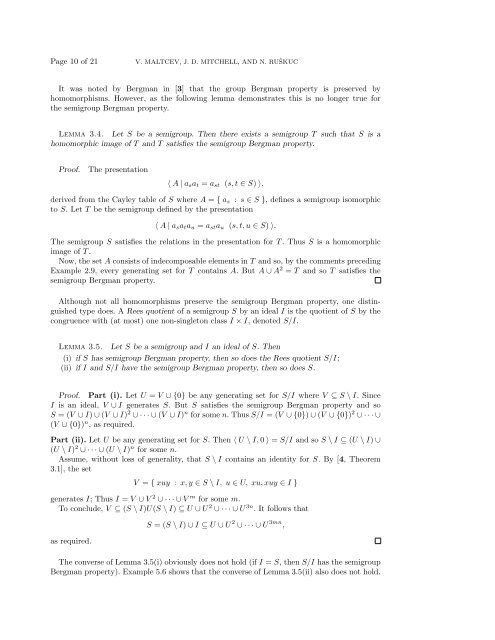The Bergman property for semigroups
The Bergman property for semigroups
The Bergman property for semigroups
Create successful ePaper yourself
Turn your PDF publications into a flip-book with our unique Google optimized e-Paper software.
Page 10 of 21<br />
V. MALTCEV, J. D. MITCHELL, AND N. RUŠKUC<br />
It was noted by <strong>Bergman</strong> in [3] that the group <strong>Bergman</strong> <strong>property</strong> is preserved by<br />
homomorphisms. However, as the following lemma demonstrates this is no longer true <strong>for</strong><br />
the semigroup <strong>Bergman</strong> <strong>property</strong>.<br />
Lemma 3.4. Let S be a semigroup. <strong>The</strong>n there exists a semigroup T such that S is a<br />
homomorphic image of T and T satisfies the semigroup <strong>Bergman</strong> <strong>property</strong>.<br />
Proof.<br />
<strong>The</strong> presentation<br />
〈 A | a s a t = a st (s, t ∈ S) 〉,<br />
derived from the Cayley table of S where A = { a s : s ∈ S }, defines a semigroup isomorphic<br />
to S. Let T be the semigroup defined by the presentation<br />
〈 A | a s a t a u = a st a u (s, t, u ∈ S) 〉.<br />
<strong>The</strong> semigroup S satisfies the relations in the presentation <strong>for</strong> T . Thus S is a homomorphic<br />
image of T .<br />
Now, the set A consists of indecomposable elements in T and so, by the comments preceding<br />
Example 2.9, every generating set <strong>for</strong> T contains A. But A ∪ A 2 = T and so T satisfies the<br />
semigroup <strong>Bergman</strong> <strong>property</strong>.<br />
Although not all homomorphisms preserve the semigroup <strong>Bergman</strong> <strong>property</strong>, one distinguished<br />
type does. A Rees quotient of a semigroup S by an ideal I is the quotient of S by the<br />
congruence with (at most) one non-singleton class I × I, denoted S/I.<br />
Lemma 3.5. Let S be a semigroup and I an ideal of S. <strong>The</strong>n<br />
(i) if S has semigroup <strong>Bergman</strong> <strong>property</strong>, then so does the Rees quotient S/I;<br />
(ii) if I and S/I have the semigroup <strong>Bergman</strong> <strong>property</strong>, then so does S.<br />
Proof. Part (i). Let U = V ∪ {0} be any generating set <strong>for</strong> S/I where V ⊆ S \ I. Since<br />
I is an ideal, V ∪ I generates S. But S satisfies the semigroup <strong>Bergman</strong> <strong>property</strong> and so<br />
S = (V ∪ I) ∪ (V ∪ I) 2 ∪ · · · ∪ (V ∪ I) n <strong>for</strong> some n. Thus S/I = (V ∪ {0}) ∪ (V ∪ {0}) 2 ∪ · · · ∪<br />
(V ∪ {0}) n , as required.<br />
Part (ii). Let U be any generating set <strong>for</strong> S. <strong>The</strong>n 〈 U \ I, 0 〉 = S/I and so S \ I ⊆ (U \ I) ∪<br />
(U \ I) 2 ∪ · · · ∪ (U \ I) n <strong>for</strong> some n.<br />
Assume, without loss of generality, that S \ I contains an identity <strong>for</strong> S. By [4, <strong>The</strong>orem<br />
3.1], the set<br />
V = { xuy : x, y ∈ S \ I, u ∈ U, xu, xuy ∈ I }<br />
generates I; Thus I = V ∪ V 2 ∪ · · · ∪ V m <strong>for</strong> some m.<br />
To conclude, V ⊆ (S \ I)U(S \ I) ⊆ U ∪ U 2 ∪ · · · ∪ U 3n . It follows that<br />
as required.<br />
S = (S \ I) ∪ I ⊆ U ∪ U 2 ∪ · · · ∪ U 3mn ,<br />
<strong>The</strong> converse of Lemma 3.5(i) obviously does not hold (if I = S, then S/I has the semigroup<br />
<strong>Bergman</strong> <strong>property</strong>). Example 5.6 shows that the converse of Lemma 3.5(ii) also does not hold.
















